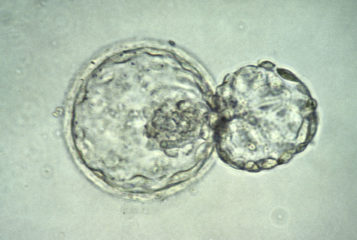As 2008 drew to a close, Science magazine announced its annual top ten breakthroughs of the year, after considering novel research that 'paves the way for future discoveries'. Work in the field of cellular reprogramming was awarded pole position, ahead of a real-time video of a developing zebrafish embryo, and the direct observation of nearby planets.
Robert Coontz, Science's deputy news editor, says: 'Cellular reprogramming opened a new field of biology almost overnight and holds out hope of life-saving medical advances'.
In 2006, Professor Shinya Yamanaka and team of Kyoto University, Japan, succeeded in converting mouse skin cells into - functionally speaking - stem cells. Appearing in the journal Cell, the paper described the introduction of just four 'master regulator' genes into the adult cells. The resultant cells are dubbed induced pluripotent stem (iPS) cells. These could be coaxed into becoming any one of hundreds of distinct cell types, yet circumvented the need for extracting stem cells from an early-stage embryo to achieve the same. This is potentially highly beneficial, as the latter process is strongly dissuaded by many on political and ethical grounds. A year on, this intriguing feat was recapitulated in human skin cells; a success recognised as first runner-up in last year's top-ten. In September 2008, Professor Yamanaka's method was awarded patent status in Japan.
Since then, Professor Yamanaka and, subsequently, Professor George Daley of the Harvard Stem Cell Institute, US, have reported creating such iPS (induced pluripotent stem) cells from patients with specific genetic disorders, such as Down syndrome and Huntington's disease. These cells can be converted into the specific cell type affected by the original donor's disease, like muscle cells in patients with a muscular dystrophy. Theoretically, any hereditary disease is amenable to such investigation.
The benefits are two-fold. Such cells could be used in drug screens and toxicology studies. They might also represent the beginning of patient-specific therapies, where genetic defects are corrected in the laboratory before the cells are re-introduced into the affected patient. There would be no organ rejection as the cells are not foreign.
Also at Harvard in 2008, a third group, led by Professor Douglas Melton, reported skipping the embryonic cell stage altogether, by converting one adult cell type to another. Published in the journal Nature, this finding went against a widely believed paradigm that suggests a cell cannot 'backtrack', let alone change identity, once it has reached its final 'personality'. Clearly, such work has culminated in a deeper appreciation of the subtleties of cellular reprogramming.
'All of us who are working with reprogramming owe a debt to Shinya Yamanaka, whose real paradigm-shifting work occurred in 2006', said Professor Daley, speaking to Science magazine after the announcement of their winner. 'For many years, we've been seeking ways to establish the cell culture models for human disease. And we've finally achieved that'.
Sources and References
-
Breakthrough of the Year 2008
-
Stem cell technique named scientific breakthrough of the year
-
Science's Breakthrough Of The Year: Cellular Reprogramming
-
Year that could be turning point on disease





Leave a Reply
You must be logged in to post a comment.